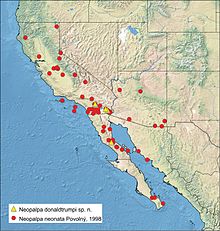Neopalpa donaldtrumpi is a moth species of the genus Neopalpa occurring in Southern California and Northern Mexico. It was described in 2017 by Iranian-Canadian scientist Vazrick Nazari. Known for its yellowish-white head scales being reminiscent of Donald Trump's hair, the moth was given its name because Nazari stated that he wanted "to bring wider public attention to the need to continue protecting fragile habitats in the US that still contain many undescribed species."[1]
| Neopalpa donaldtrumpi | |
|---|---|

| |
| Adult male specimen | |
| Scientific classification | |
| Domain: | Eukaryota |
| Kingdom: | Animalia |
| Phylum: | Arthropoda |
| Class: | Insecta |
| Order: | Lepidoptera |
| Family: | Gelechiidae |
| Genus: | Neopalpa |
| Species: | N. donaldtrumpi
|
| Binomial name | |
| Neopalpa donaldtrumpi Nazari, 2017
| |

| |
| Distribution of N. donaldtrumpi (yellow triangles) | |
Discovery edit
The genus Neopalpa, including the species Neopalpa neonata, was first described in 1998 by Dalibor Povolný.[2] Almost two decades later, Nazari reviewed the material, including specimens that had been collected since the first description of the genus, from the Bohart Entomology Museum.[3] He considered that some of the specimens formed a new species. In January 2017 he published an article naming it Neopalpa donaldtrumpi for the yellowish-white color of the scales on the head, which reminded him of then President-elect Donald Trump's hairstyle.[4][5]
Description edit
The upper surface of the N. donaldtrumpi forewings is orange-yellow except for dark brown patches on the fringe and anterior portions of the wing. The length between forewings is 3 mm (0.12 in) to 4.6 mm (0.18 in). Hindwings are pale buff, with dark fringes. The wings have similar coloration for both males and females. Its antennae are about two-thirds of its wingspan and its head is covered with yellowish white scales, which inspired the moth's name.[4][5] Compared with N. neonata, the other species in the genus, N. donaldtrumpi male genitalia structures are smaller and female genitalia possess very few small setae.[4]
Distribution edit
While the closely related N. neonata occurs throughout much of California, Baja California and Northwest Mexico, specimens of N. donaldtrumpi have so far been found only in the Northern half of Baja California and Riverside and Imperial counties in Southern California.[4]
Biology edit
Neopalpa donaldtrumpi belongs to the twirler moths, known for their propensity to spin in circles on leaves.[6] The moth appears to be evenly distributed through the year, but its host plant and lifespan are not known.[7] Its habitat is threatened by urbanization.[8]
See also edit
References edit
- ^ Samuelson, Kate (January 18, 2017). "Scientists Just Named a Tiny Moth After Donald Trump: The moth's official name is Neopalpa donaldtrumpi". Time. Retrieved January 23, 2017.
- ^ Povolný, Dalibor (1998). "Neopalpa gen. n. and Eurysaccoides gen. n. – two new genera of the tribe Gnorimoschemini from California, with the description of three new species (Lepidoptera, Gelechiidae)". Revista de Lepidopterología. 26: 139–146.
- ^ Fitch, Chris (January 18, 2017). "Meet the Trump moth". Geographical. Royal Geographical Society. Archived from the original on August 4, 2019. Retrieved January 20, 2017.
- ^ a b c d Nazari, Vazrick (2017). "Review of Neopalpa Povolný, 1998 with description of a new species from California and Baja California, Mexico (Lepidoptera, Gelechiidae)". ZooKeys (646): 79–94. Bibcode:2017ZooK..646...79N. doi:10.3897/zookeys.646.11411. PMC 5299441. PMID 28228677.
- ^ a b "Neopalpa donaldtrumpi Motte trägt nun Namen von Donald Trump", Der Spiegel, January 18, 2017 (German)
- ^ Burdick, Alan (January 20, 2017). "The Metaphorical Meaning of a Moth Named after Trump". The New Yorker. Retrieved January 23, 2017.
The genus belongs to a wider family, Gelechiidae, the twirler moths, so called for their habit of spinning in circles on the surface of leaves.
- ^ "Research: Recently described moth named in honour of new U.S. president". BirdGuides. January 20, 2017. Retrieved January 23, 2017.
- ^ Raphael, John (January 19, 2017). "New Moth Species With Yellowish-White Scales, Small Genitals Named After Donald Trump". Nature World News. Retrieved January 23, 2017.
External links edit
- Media related to Neopalpa donaldtrumpi at Wikimedia Commons
- Neopalpa donaldtrumpi at BOLD (Barcode of Life Data System)